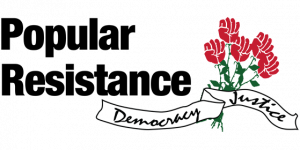Constantly changing in response to new situations makes it more difficult for law enforcement, the government, and corporations to predict what the movement will do.
By Kevin Zeese & Margaret Flowers
Popular Resistance (5/3/20)
Now that May Day is behind us, we must build the General Strike campaign. The next strike day, June 1, should be the culmination of a month of working toward the day of action. This is the responsibility of everyone involved in the General Strike movement.
Join the next Popular Resistance General Strike call on Thursday, May 28 at 7:00 pm Eastern. Register at bit.ly/MayDayMeeting.
This is an ongoing campaign. We emphasize it is a campaign as campaigns provide ongoing opportunities to build the movement. The goal is to ensure that those running for office, those in office and those who make policy — including non-profits, corporations, and the media — cannot ignore the movement as we demonstrate our ability to make the country ungovernable.
To do this we need to build a movement that: (1) Creates national consensus for our demands, and (2) Involves enough people to be a mass movement that cannot be ignored. This requires people to act at local and national levels to build the movement as described below.
Educating and Organizing
The foundation of movement building is popular education followed by organizing and mobilizing people. People need to understand what the problems are, why the current system won’t solve them and what will solve them. Movements have short, medium and long-term goals.
In the short term, we need to ensure that essential workers are protected from the virus and are paid well for taking health risks, that there are widespread testing and tracking of the virus, and that people receive enough income to survive the economic collapse in both unemployment and direct basic income payments. Another urgent need is to save the Postal Service in the next COVID-19 bailout by Congress.
Longer-term changes include universal healthcare through national improved Medicare for all, fair treatment of workers and living wages, family and sick leave as well as safe workplaces, a guaranteed basic income, remaking the finance system so we are not dependent on Wall Street but on public banks throughout the country, Congress taking back the constitutional power to create money and more. We need to end racial discrimination, injustice, and inequality in income, education, housing, incarceration, and other areas that have been further exposed by the COVID-19 pandemic.
Each of these goals is an opportunity to build a movement of movements by reaching out to people and organizations who are working on workers’ rights, healthcare, racism, inequality, housing, poverty, and other issues included in our demands. We need to understand how our issues are connected so that together we fight for all of them. For example, improving healthcare through national improved Medicare for All (NIMA) will reduce inequality and enhance the rights of workers. Currently, more than 10 million people have lost their healthcare due to more than 30 million becoming unemployed. With NIMA, healthcare will no longer be dependent on employment. It will cease to be a tool the bosses use to cut pay or threaten workers when they strike. And health is connected to social issues such as education, housing, access to healthy food, clean air and water and more.
A tool for learning how to organize and mobilize people in an effective way is the free Popular Resistance School “How Social Transformation Occurs.” This is a web-based school that includes eight classes and a detailed curriculum. We all need to become capable in building the movement. Please watch this series of classes and review the reading materials.
People can organize local General Strike Committees made up of people and organizations working on these issues. The committees will meet regularly, which can be done virtually through online platforms, to provide both education and to organize actions for the general strike, as well as creating local mutual aid networks to get through the pandemic and economic crisis.
We need to act with the intention of creating a national political consensus on the issues and building a mass movement. We should judge our outreach, organizing and actions by whether what we are doing is accomplishing those goals. We describe tools for movement-building in the final class of the eight-class web-based School for Social Transformation.
Your group can review the demands and analyze how you can reach out to and involve people and organizations working on those issues. Develop strategies to reach out to those groups and involve them. Your actions on June 1 could be designed to pull groups in, e.g. conduct an automobile picket line at Target, Whole Foods or Walmart to support the workers or conduct banner drops or hold signs near a hospital. Include information about how people who see you can get involved.
Between strike days you can also build solidarity by holding events online that bring people together and build relationships. This could include a book review, movie watching, or webinar. These can be used for not only building relationships but for outreach and deeper understanding of issues to achieve national consensus on our demands. …


